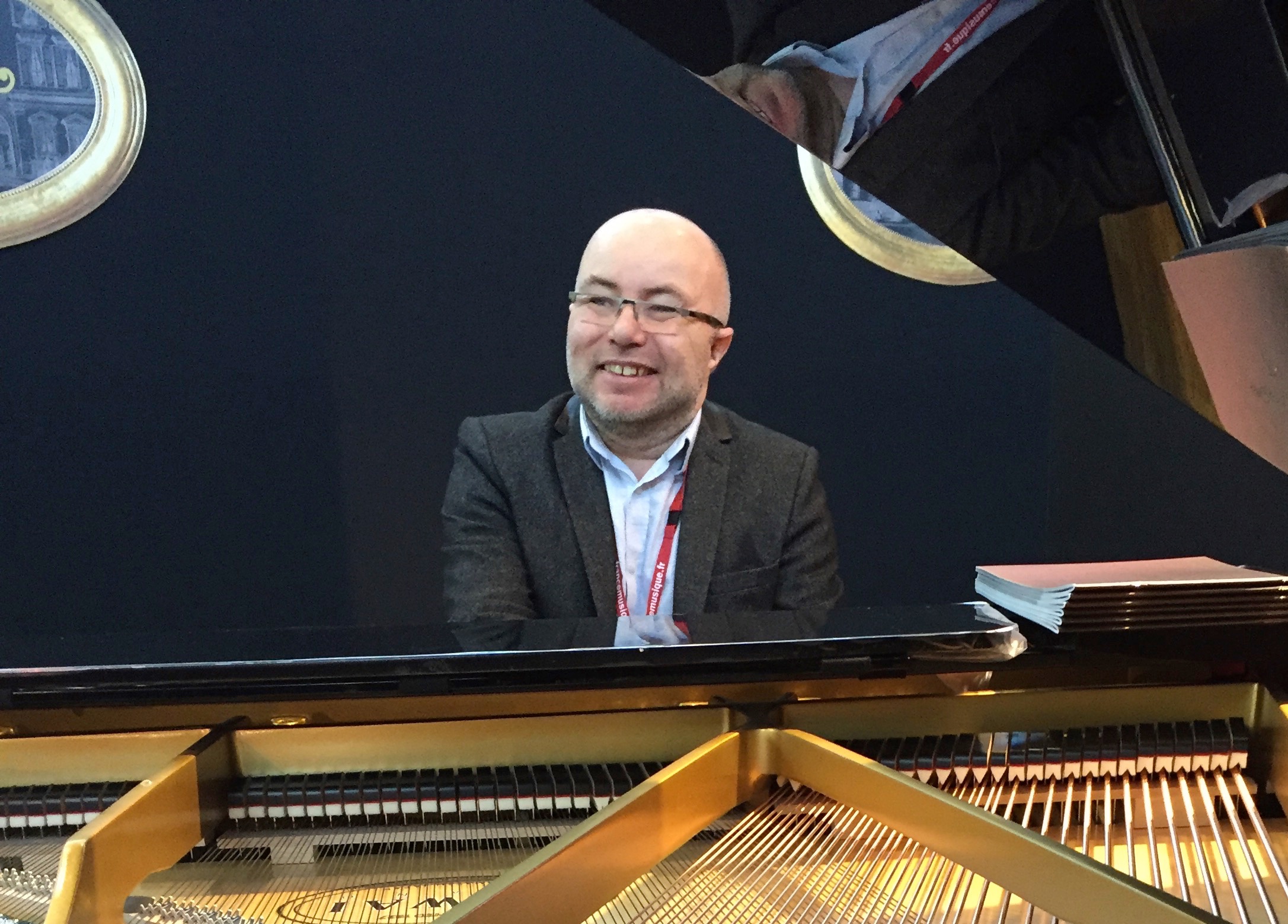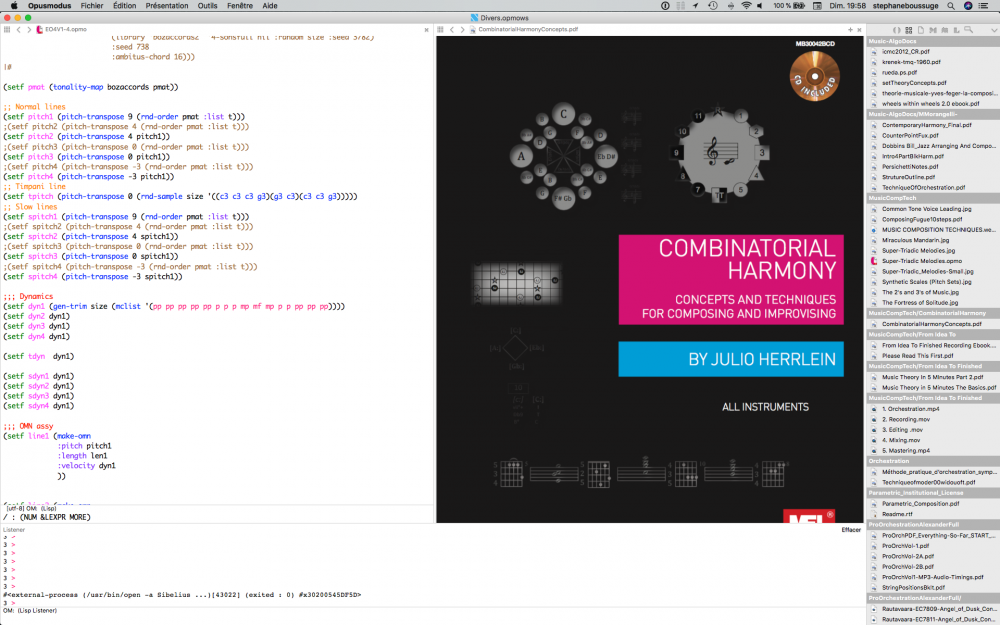-
Posts
1,058 -
Joined
-
Last visited
Content Type
Forums
Events
Store
Video Gallery
Everything posted by Stephane Boussuge
-
(list (chord-inversion 1 (expand-chord '(c4 69)))) S.
-

Opusmodus Vs. Symbolic Composer
Stephane Boussuge replied to Jorgalad's topic in Pre Sales Questions
I think Scom send just the midifile to Logic. If you open a midi-file created with Opusmodus with Logic, all the tracks will be created, the tempo map, the bar changes and logic will load instruments exactly as you describe. It is just opening the midi-file into logic. S. -

Opusmodus Vs. Symbolic Composer
Stephane Boussuge replied to Jorgalad's topic in Pre Sales Questions
You can look at some of my videos tutorials in the Videos section on this Forum - you will see how to drive Logic Pro. In Opusmodus you can use as many MIDI ports as you like with hundreds of MIDI channels simultaneously. Opusmodus have all you need to create and send cc (controllers) data - check the DEF-SOUND-SETS documentation and the DEF-SCORE documentation. About driving Logic, I have created two templates which you'll find in templates section on this Forum. Happy Opusmodusing ;-) Stéphane Boussuge -
Wonderful and great video !! S.
-

Playback of articulations
Stephane Boussuge replied to torstenanders's topic in Support & Troubleshooting
i agree totally :-) Actually, i always finish my scores in a DAW for such reason but with this new possibilities into Opusmodus, it would be no more necessary and i love the idea to stay in Opusmodus from start to end of the music process. SB. -

Changing MIDI channels with articulations
Stephane Boussuge replied to torstenanders's topic in Support & Troubleshooting
i would love a possibility to change midi channel from articulation :-) S -

audio Nuit d'hiver For Woodwinds
Stephane Boussuge replied to Stephane Boussuge's topic in Made In Opusmodus
Thank you :-) -
Small piece for Woodwinds. S.
-
Here's my way for diatonic transposition. It is very simple but do exactly what i want when composing I use this system extensively in all my compositions now, not always in diatonic context but also with synthetic modes, row, algorithmic pitch material etc... I love the concept of degree and transpositions inside a scale and use that technique very often. (setf motiv '((q c4 e4 g4)(q c4 e4 g4)(q c4 e4 g4)(q c4 e4 g4)(q c4 e4 g4))) (setf degree '(1 4 2 5 1)) (setf harmonic-path (harmonic-progression degree '(c4 major) :step 1 :size 7 :base 1 )) (setf p1 (tonality-map (mclist harmonic-path) motiv)) S.
-

score November 13th Strings Trio
Stephane Boussuge replied to Stephane Boussuge's topic in Made In Opusmodus
Score files updated with missing functions 1/F-values and euclidean-rhythms. SB. -
Nigel was passed away on 14th September 2017. The funeral was only with his family. S.
-
I consider Nigel was my most important music comp. teacher even if we had mainly only mails exchange and few meetings and i will be always thankful to him for his always very constructives advices. S.
-
-
Logic now from at leat one year use multiple core when bussing via live instruments but may be not with armed tracks but sure with the configuration i've shared long time ago on this Forum: All the best. S.
- 8 replies
-
- polytempo
- mixed simultaneous tempos
-
(and 1 more)
Tagged with:
-

Group orchestration / instrumentation example
Stephane Boussuge replied to Stephane Boussuge's topic in Score and Notation
I am a bit overbooked actually and didn't took the time to comment it correctly, but you've made it :-) Thank you Torsten ! In fact the variables grp1, grp2 etc.. are like orchestration presets and can be (for example) stored in a library file to be recalled algorithmically. S. -

Group orchestration / instrumentation example
Stephane Boussuge posted a topic in Score and Notation
Hi, An example of group orchestration. I first create some binary représentation of some group of instruments and apply this groups with do-timeline: ;;; Parameters (setf size 12) ;;; Length generation (setf len1 (euclidean-rhythm (gen-repeat size '(16)) 1 12 's :type 2)) (setf len2 (euclidean-rhythm (gen-repeat size '(16)) 1 12 's :type 2)) (setf len3 (euclidean-rhythm (gen-repeat size '(16)) 1 12 's :type 2)) (setf len4 (euclidean-rhythm (gen-repeat size '(16)) 1 12 's :type 2)) ;;; Pitch generation (setf pmat (gen-divide 8 (vector-to-pitch '(c3 c5)(gen-white-noise 32)))) (setf pch1 (pitch-transpose 12 (rnd-sample size pmat))) (setf pch2 (pitch-transpose 8 (rnd-sample size pmat))) (setf pch3 (pitch-transpose 0 (rnd-sample size pmat))) (setf pch4 (pitch-transpose -24 (rnd-sample size pmat))) ;;; Global dynamics (setf dyna (mclist (pink-noise-sample 64 '(pp p mp mf f ff)))) ;;; OMN assembly (setf line1 (make-omn :pitch pch1 :length len1 :velocity dyna)) (setf line2 (make-omn :pitch pch2 :length len2 :velocity dyna)) (setf line3 (make-omn :pitch pch3 :length len3 :velocity dyna)) (setf line4 (make-omn :pitch pch4 :length len4 :velocity dyna)) (setf flute line1) (setf oboe line2) (setf clarinet line3) (setf bassoon line4) ;;; Orchestration and post processing ;; Ambitus (setf flute (ambitus '(g4 c6) flute)) (setf oboe (ambitus '(d4 d5) oboe)) (setf clarinet (ambitus '(c4 g5) clarinet)) (setf bassoon (ambitus '(c2 g3) bassoon)) ;; Re-barring (setf master-meters '(4/4)) (setf flute (omn-to-measure flute master-meters)) (setf oboe (omn-to-measure oboe master-meters)) (setf clarinet (omn-to-measure clarinet master-meters)) (setf bassoon (omn-to-measure bassoon master-meters)) ;; Mute / play (setf olen (length flute)) ;(setf otime (rnd-sample 8 '(wwww www ww w h w ww www))) (setf otime 1) ;; Group orchestration (setf grp1 '(1 1 0 0)) (setf grp2 '(1 1 1 0)) (setf grp3 '(1 1 1 1)) (setf grp4 '(1 0 1 1)) (setf grp5 '(0 0 1 1)) (setf grp6 '(1 1 0 1)) (setf grp7 '(1 0 1 1)) (setf i-list '(grp1 grp2 grp3 grp4 grp5 grp6 grp7)) (setf orchestration (rnd-sample olen i-list)) (setf orch-proc1 (binary-invert (apply-eval orchestration))) (setf instrumentation (matrix-transpose orch-proc1)) (do-timeline2 '(flute oboe clarinet bassoon) instrumentation '(gen-pause x) :time otime) (setf ts (get-time-signature flute)) (def-score group-orch-example (:title "Group orch example " :composer "S.Boussuge" :copyright "2017 s.boussuge " :key-signature 'chromatic :time-signature ts :tempo 88 :layout (list (bracket-group (flute-layout 'flute) (oboe-layout 'oboe) (clarinet-layout 'clarinet) (bassoon-layout 'bassoon)))) (flute :omn flute :channel 1 :sound 'gm :program 'flute :volume 95 :pan 70 :controllers (91 '(52))) (oboe :omn oboe :channel 2 :sound 'gm :program 'oboe :volume 95 :pan 54 :controllers (91 '(55))) (clarinet :omn clarinet :channel 3 :sound 'gm :program 'clarinet :volume 95 :pan 60 :controllers (91 '(57))) (bassoon :omn bassoon :channel 4 :sound 'gm :program 'bassoon :volume 95 :pan 70 :controllers (91 '(57))) ) SB. Group & Orchestration.opmo -

Randomize Materials?
Stephane Boussuge replied to Ioannis Andriotis's topic in User Extensions Source Code
i will think about this idea. All the best ! S. -

Randomize Materials?
Stephane Boussuge replied to Ioannis Andriotis's topic in User Extensions Source Code
;; Number of bars (setf size 12) ;;; Random weighted choice of pitches with emphasis on d4 gs4 abd as4 (setf pitch (gen-weight size '((c4 1)(cs4 1)(d4 2)(ds4 1)(e4 1)(f4 1)(fs4 1)(g4 1) (gs4 2)(a4 1)(as4 2)))) ;;; Slightly varied rythm pattern based on a random choice ;;; of rythmic cells varied by rest positionning. ;; rythmic cells definition (setf rcells '((s s s s q e e q)(e e e e e e e e)(s s e s s e s s s s s s s s))) ;; random choice of rythmic cells (setf rchoice (rnd-sample size rcells)) ;; Length definition, adding some rests (setf len (length-weight rchoice :weight '(3 1))) ;;; Pitch and length assembly into an omn phrase: (setf phrase1 (make-omn :pitch pitch :length len )) Happy Opusmodus exploration ! SB. -
You may use the gen-repeat-seq function for the repetitions. You can have a look also to omn-to-measure , it could be useful also in what you doing. Cheers S.
-
Quartal example: (harmonic-progression '(1 2 3 4 5 6 7) '(d4 natural-minor) :size 4 :step 3 :base 1 ) Another example more complex: (setf row (rnd-row :type :pitch :transpose 2)) (setf chords1 (harmonic-progression (rnd-number 24 -6 6) row :size (rnd-sample 24 '(3 4 5 6)) :step (rnd-sample 24 '(1 2 3 (2 3)(1 3))) )) S.
- 5 replies
-
- chords
- progression
-
(and 1 more)
Tagged with:
-

saving the output (omn) in a seperat file
Stephane Boussuge replied to AM's topic in User Extensions Source Code
Somewhere on this forum, there is an example from Janusz on how to implement the seed in you own function... S.




